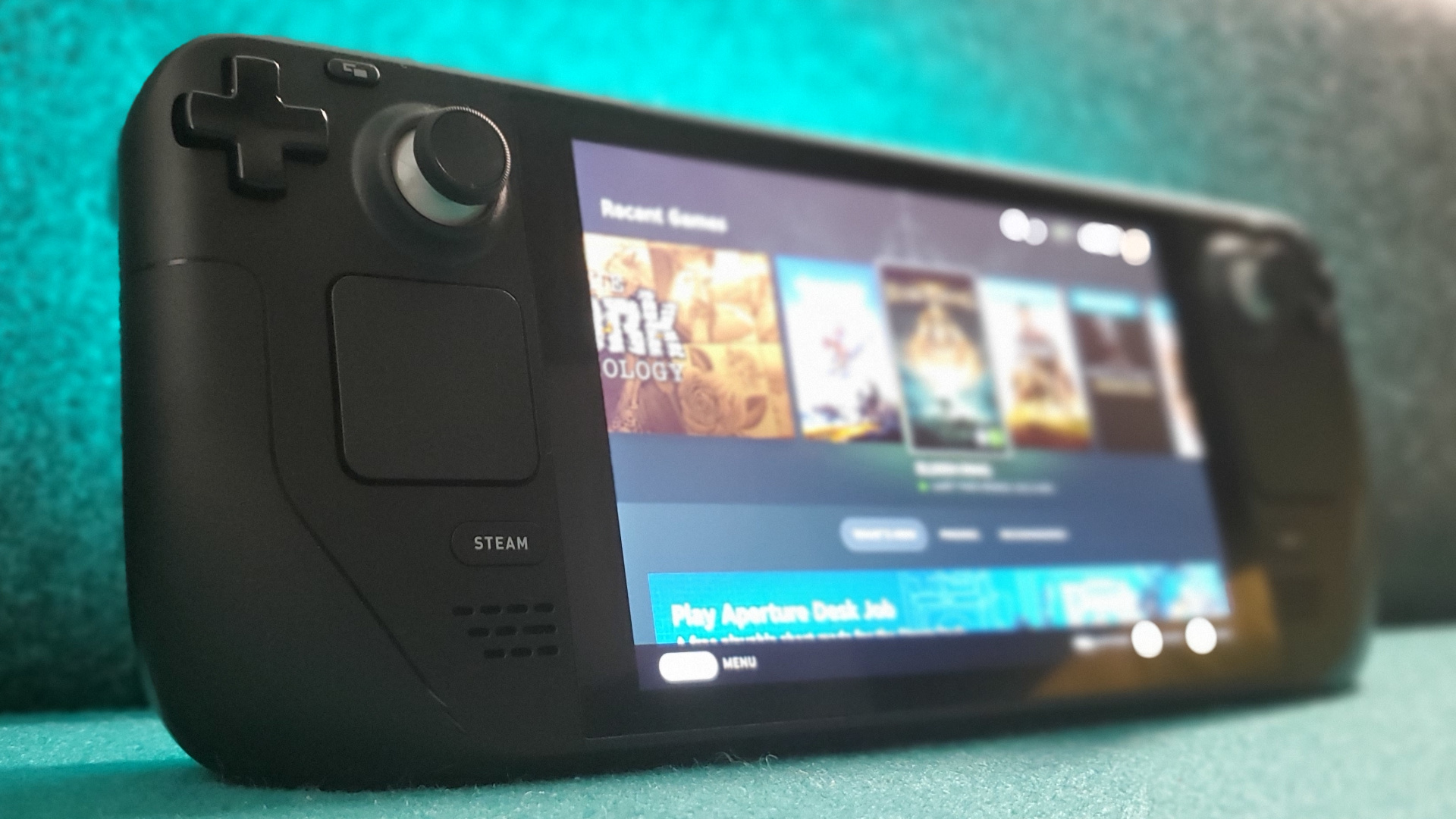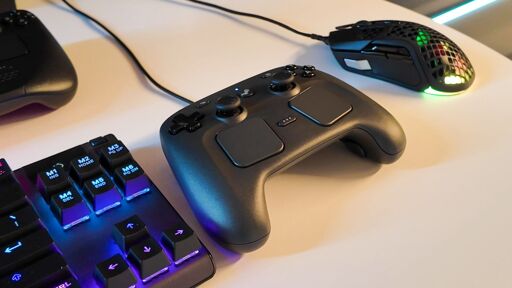Of the three hardware announcements Valve made yesterday, the Steam Controller is probably the least exciting at face value. It looks a whole lot like the original Steam controller, which hardly set the world ablaze. Also, it’s a gamepad. There are countless PC gamepads on the market, and many are better than what Microsoft or Sony have to offer. We have 1000 Hz polling rates, TMR sticks, and near-mandatory paddle buttons. Sometimes they even have a screen on them, and if you’re lucky, a sprinkling of RGB too. Surely we’re good.
Valve’s hot hardware

(Image credit: Future)
Steam Frame: Valve’s new wireless VR headsetSteam Machine: Compact living room gaming boxSteam Controller: A controller to replace your mouse
We’re good if we think about a gamepad as a fast-track to a conventional console experience on our PCs. But after a year spent with Steam Deck and its trackpads, I’ve come to appreciate, at least in part, why Valve put those gargantuan circular trackpads on their original design: because it makes swathes of otherwise unplayable PC games playable under circumstances where a mouse and keyboard isn’t practical or desirable.
Valve’s infiltration of console orthodoxy with the Steam Deck was so much more subtle than just: Cyberpunk 2077 on the bus and you can tweak the graphics. Among other things, it was soft power advocacy for onboard trackpads. Taking trackpads mainstream could be part of the Steam Deck’s legacy, or at least I hope that’s the case. I’m so trackpad-pilled that I can’t imagine another generation of consoles that doesn’t adopt Valve’s implementation. There are more powerful handheld PCs on the market than Steam Deck, but I will never consider buying them if they don’t have trackpads.
Pillars of Eternity turned me into a trackpad truther. It seemed a perfect Steam Deck candidate. It was among the first games I installed on the handheld when I got one, mostly because it’s a very text-heavy game (basically a novel at times) and I didn’t want to bend over a laptop or sit at a desk while reading tracts of high fantasy lore. Alas, while Obsidian’s CRPG eventually released for consoles, the console gamepad UI was never patched into the PC version. A community layout implementing the trackpads as a stand-in for a mouse is pretty much essential for the handheld-determined. I begrudgingly made do.
I begrudgingly made do for a while: for about an hour I was still annoyed that Obsidian hadn’t patched the PC version with the gamepad trimmings (I almost posted on Reddit). But after about an hour—no longer—I became accustomed to using the trackpads, and had a grand time over the ensuing 80 hours playing this ostensibly mouse-and-keyboard CRPG without a mouse and keyboard. I came to love it so much that when I installed Wasteland 3—which does have gamepad functionality built-in—I much preferred using a mouse-and-keyboard system adapted for trackpads, despite the enduring annoyance of keyboard UI prompts. Rather than learn which trigger or bumper accesses a certain nested sub-menu, or which long-press initiated a hidden menu, I could simply—without a mouse—point ‘n’ click. Adapting to a new thumb-centric muscle memory is about three-quarters of an hour of your time at worst. It pays off.

The original 2015 Steam Controller. (Image credit: Valve)
The beauty of the trackpads was well ingrained by the time I completed Pillars of Eternity on a handheld: I enjoyed the game with no sense of being at a disadvantage, and handling it on a Steam Deck felt normal and good, usually great. But that’s not what sold me entirely on trackpads. Earlier this year I was taken by a fleeting obsession with 1990s point ‘n’ click adventures. I bought Sanitarium, Harvester, a couple of Gabriel Knight games (rocky affairs thanks to a wily Linux-filtered DOSBox, but still playable) and even the keyboard-shortcut-heavy Realms of Arcadia blobbers. It probably goes without saying that none of these games were designed with gamepads in mind.
Sanitarium (1998) is completely, comfortably playable on the Steam Deck thanks to the track pads. Harvester (1996), while cheerfully dumb as shit, was perfectly playable too. Gabriel Knight: Sins of the the Fathers (1993) and the Realms of Arcadia games (1992 onwards) took a little more adjustment, thanks to their reliance on keyboard inputs, and I can’t say I stuck with them long, but I was definitely able to navigate them for an hour or so with increasing comfort, and I knew that a bit of fiddling could have made them sing.
The significance of this might be lost on younger readers, but it’s worth being specific for the elders: it’s provenly possible to play the ghastly point ‘n’ click deep cut Bad Mojo (1996) on Steam Deck. Which means, it’ll theoretically be possible to sit on a couch, vomit bag in tow, with a Steam controller, and play that old cockroach odyssey on a large screen in the very near future. Perhaps you’ve already done so, with the old Steam Controller. If that’s you, great: you’re akin to the uncle who saw Hendrix at Isle of Wight. The overall point is this: trackpads render wide swathes of otherwise gamepad-unfriendly PC games gamepad friendly. For people who love PC gaming, but don’t always love the whole sitting-at-a-desktop-PC aspect of it, it’s transformative.
There’s a reason the Steam Controller of 2025 looks a whole lot like the Steam Controller of 2015: It’s a good idea, but it didn’t have an obvious use case to justify it
PlayStation’s DualSense has a trackpad, and so does the DualShock 4, but they’re awkwardly placed. They’re tentative toe dips, scarcely used and when they are, a superfluous novelty, untethered from moment-to-moment interaction. Their implementation reminds me, for its infancy, of the analog stick on the Nintendo 64 controller. Nintendo knew that an eight-directional stick would factor heavily into the future, but they didn’t know exactly how to execute on it. PlayStation was watching, and eventually adopted not one but two symmetrical sticks on its own controller, thus completely changing the way we handle games into the 21st century.

(Image credit: Future)
PlayStation and Nintendo are inarguably pioneers when it comes to how games are controlled in a modern gamepad context, but in the current climate, their implementation of new technologies, such as trackpad and touchscreen, feels rudimentary. For the most part, PlayStation games use the trackpad for menu navigation or, at best, tactile mini-games. At worst, it’s just a big ol’ button to access an open world map. Nintendo’s dalliances with touchscreen across Wii U and Switch haven’t been much more innovative. But the way we handle games defines them, almost entirely. The envelope cannot be pushed past a certain threshold without the widely accepted input language evolving, even a tad, and that means not more inputs, but potentially different ways to input.
The trackpad probably won’t be as revolutionary as the analog stick, but it definitely opens avenues for different kinds of experiences in vastly different playing contexts. We certainly won’t be comfortably playing text adventures or Dwarf Fortress with a Steam Controller, but the finer gradients of control—if it catches on—could give rise to different kinds of game, or at least better varieties of games we’ve played, merging the fine grain specificity of a drag-and-pull mouse with the pleasures of analog sticks and microswitches. It’s not just about, for example, precision in first-person shooters, which is how I remember a lot of people justifying the touchpads on the original Steam Controller.
In 2015, Valve seemed mad for its weirdo trackpad controller and the market told it so: in 2025, Valve has demonstrated not only that it can work, but that it feels good. There’s a reason the Steam Controller of 2025 looks a whole lot like the Steam Controller of 2015: It’s a good idea, but it didn’t have an obvious use case to justify it. Steam Deck is the use case’s trojan horse.
Valve is well-placed to demonstrate it too. Half-Life 3 comes to mind, though Deadlock will probably do. Knowing Valve, they’ll let users and other studios do the talking.
&
The best PC gaming gear 2025
All our current recommendations
Pick a category Best overallCore ComponentsChairs & DesksSystems & LaptopsScreensPeripheralsCases, Cooling & Storage Choose a list The best PC gaming gear 2025  BEST GAMING CHAIR 1. Secretlab Titan Evo Check Price
BEST GAMING CHAIR 1. Secretlab Titan Evo Check Price  BEST GAMING DESK 2. Secretlab Magnus Pro XL Check Price
BEST GAMING DESK 2. Secretlab Magnus Pro XL Check Price  BEST GAMING HEADSET 3. HyperX Cloud Alpha Check Price
BEST GAMING HEADSET 3. HyperX Cloud Alpha Check Price  BEST GAMING KEYBOARD 4. Asus ROG Strix Scope II 96 Wireless Check Price
BEST GAMING KEYBOARD 4. Asus ROG Strix Scope II 96 Wireless Check Price  BEST GAMING MOUSE 5. Razer DeathAdder V3 HyperSpeed Check Price
BEST GAMING MOUSE 5. Razer DeathAdder V3 HyperSpeed Check Price  BEST PC CONTROLLER 6. Xbox Wireless Controller Check Price
BEST PC CONTROLLER 6. Xbox Wireless Controller Check Price  BEST STEERING WHEEL 7. Logitech G Pro Racing Wheel Check Price
BEST STEERING WHEEL 7. Logitech G Pro Racing Wheel Check Price  BEST MICROPHONE 8. Shure MV6 Check Price
BEST MICROPHONE 8. Shure MV6 Check Price  BEST WEBCAM 9. Elgato Facecam MK.2 Check Price Read the full guide: The best PC gaming gear 2025POWERED BY
BEST WEBCAM 9. Elgato Facecam MK.2 Check Price Read the full guide: The best PC gaming gear 2025POWERED BY &&&&&&&&&&&&&&&&&&&&&&&&&&&&&&&&&&&&&&&&&&&&&&&&&&&&&&&&&&&&&&&&&&&&&&&&&&&&&&&&&&&&&&&&&&&&&&&&&&&&&&&&&&&&&&&&&&&&&&&&&&&&&&&&&&&&&&&&&&&&&&&&&&&&&&&&&&&&&&&&&&&&&&&&&&&&&&&&&&&&&&&&&&&&&&&&&&&&&&&&&&&&&&&&&&&&&&&&&&&&&&&&&&&
&&&&&&&&&&&&&&&&&&&&&&&&&&&&&&&&&&&&&&&&&&&&&&&&&&&&&&&&&&&&&&&&&&&&&&&&&&&&&&&&&&&&&&&&&&&&&&&&&&&&&&&&&&&&&&&&&&&&&&&&&&&&&&&&&&&&&&&&&&&&&&&&&&&&&&&&&&&&&&&&&&&&&&&&&&&&&&&&&&&&&&&&&&&&&&&&&&&&&&&&&&&&&&&&&&&&&&&&&&&&&&&&&&&
From PCGamer latest via this RSS feed


